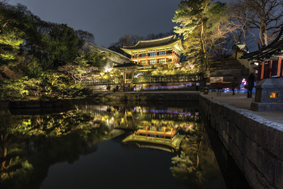
The Changdeokgung Palace had a longer reign than any king ever ruled in South Korean history. Around 270 years, it served the regime and was the royal residence for the Joseon Dynasty. Actually, Changdeokgung Palace is the longest serving royal residential palace. Out of all the royal palaces in South Korea, it has its original features intact and in good shape unlike other palaces. In 1405, King Taejong, the third Joseon Dynasty king to rule the nation, was responsible for building the Changdeokgung Palace at the foot of Mount Eungbongsan in Hanyang, or the present-day Seoul, the capital city of South Korea.
In the early period, Changdeokgung Palace was considered as the subsidiary to the main palace of Gyeongbokgung Palace until the Japanese invaded Korea from 1592-1598, and had Gyeongbokgung Palace burnt to the ground.
From there, Changdeokgung took over as the new home of the Joseon Dynasty, becoming a national symbol to the Koreans during the years of invasion. Centuries later, the palace was destructed by the Japanese during its attack in 1910-1945. It was neglected for years after that, but was finally restored in 1991.
Today, Changdeokgung is one of the most beautiful palaces in Seoul and is filled with tourists — foreign and Korean.
The palace’s design was considered as progressive at that time; the architecture takes its lead from its immediate surroundings. Complementing its landscape and keeping the indigenous tree cover intact, its royal residents and nature co-existed in harmony, and the buildings of the palace had very little artificial features.
The Changdeokgung Palace itself was a stellar example of Far Eastern palace architecture that was shaped by its environment.
Upon entering the main gate of the palace, we encounter the stone pillars standing firm on the sides of the path leading to the main building. Hundreds of years ago, the dynasty’s high-ranking officials flocked behind each of their designated pillars to have an audience with the king. Now, travellers from all around the globe gather around these lonely monuments from the past to envision the luxurious lives of the palace.
The throne hall of Changdeokgung was used for major state events - the coronations of eight kings of the Joseon Dynasty were hosted there. It’s also known as the Injeongjeon hall, was built along with Changdeokgung from the start, but, like the Changdeokgung, has seen numerous attacks by fire — it was destroyed by fire twice in 1592 and 1803, and subsequently rebuilt. Injeongjeon hall has been declared as a national treasure, along with other buildings in the palace, such as the Seonjeongjeon hall and Huijeongdang hall.
The other attraction in the palace is the secret garden, Huwon, which is tucked away behind the palace, making up about 60 per cent of the Changdeokgung Palace with its sprawling grounds, is also an example of the type of classical garden design to be found during its time. It is South Korea’s only royal garden that was erected at the rear of the palace.
Buyongji, a giant lotus pond, is found in the middle of the garden along with the two other pavilions of Buyongjeong and Juhapru. A cross-shaped roof and two supporting pillars that emerge from this pond make the design an even more distinctive one. The Juhapru pavilion, with its royal library, was a conductive study for the king and his courtiers. It also served as the resting place for royal family members.
With the huge influence it had in developing the architecture, landscape planning and garden planning of South Korea, the Changdeokgung Palace has emblazoned a position in the Unesco’s World Heritage Site list in 1997. Unesco describes the palace as “an outstanding example of Far Eastern palace architecture and garden design, exceptional for the way in which the buildings are integrated into and harmonised with the natural setting, adapting to the topography and retaining indigenous tree cover”.
Some people say that autumn is the best time of year to discover the true qualities of the palace but, others say, a winter walk in the garden admittedly brings a pleasure of discovering its amicable harmony with the nature.
But in the 1880s, it was empty and abandoned because many believed it was haunted by the evil acts of the Korean nobility.
—[email protected]
Visit the Palace
Entry: Entrance fee for the palace is 3000 Won (free if over 65) and 8000 with the secret garden. Children and teenagers (ages 24 and under) are free.
English tour (free) at 10.30am, 45 minutes for the palace and at 11.30am for the secret garden.
Visit during spring or autumn, and don’t miss the Moonlight Tour. People spend approximately 2 hours here.
Timings: Feb-May, Sept-Oct 09:00-18:00, June-Aug 09:00-18:30, Nov-Jan 09:00-17:30
Closed on Mondays
Flights: From Muscat to Seoul
l Oman Air, Etihad via Abu Dhabi, Duration 11 hours
l Oman Air, Korean Air via Dubai, Duration 11 hours 10 minutes